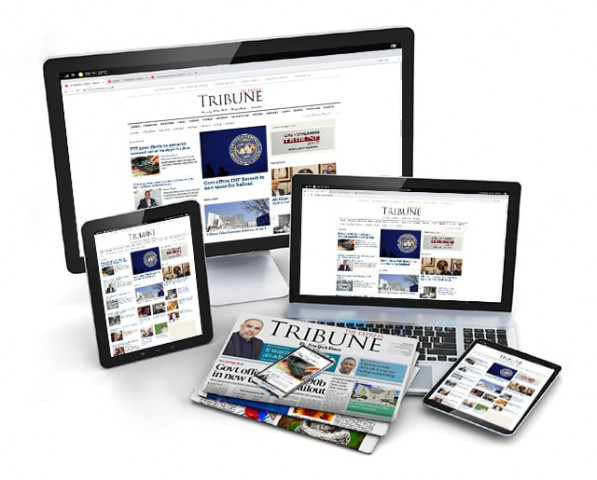
Although the story did not get as much traction in the public sphere as the outlined results seemed to merit, the trends highlighted by the Washington-based non-partisan think tank were indicative of the future of news publications in the world at large.
Conventional wisdom dictates that ever since the digital age was ushered in, with ease of access to internet technology and cheap, mass-produced electronic devices, print has been losing appeal with the public. However, conflicting reports routinely emerge which challenge this point of view.
A look at the Twitter profile of US mail bombing suspect Cesar Sayoc
The digital versus print debate can also be widened by looking through the lens of class, gender, and ethnicity. In Pakistan, for example, a large number of people still cannot read and write, and with online platforms, find it easier to explore news content which is free and more interactive.
Several studies also contend that digital publishing has introduced the modern, urban lifestyle to women of all backgrounds, thereby playing a small, but decisive role in expanding their otherwise limited horizons.
Also, with local conflicts increasingly becoming the focus of attention in the struggle for identity recognition, digital media has been an important precursor of change in recent years.
Foreign info ops: Pakistan mentioned in over 5,000 tweets
By comparing statistical trends in print and digital versions of The Express Tribune, the following paragraphs attempt to provide readers with an analysis of news consumption in the country.
The analysis is based on keywords from headlines of top stories in both mediums from January 1, 2018, to December 15, 2018. Front page headlines from print and top stories of the day on the digital version are generally the most widely read news items.
Data has been grouped into certain overriding themes, like politics, security, judiciary, social development, and foreign policy. Conclusions have been drawn based on the numbers and presented to the reader in the context of contemporary developments.
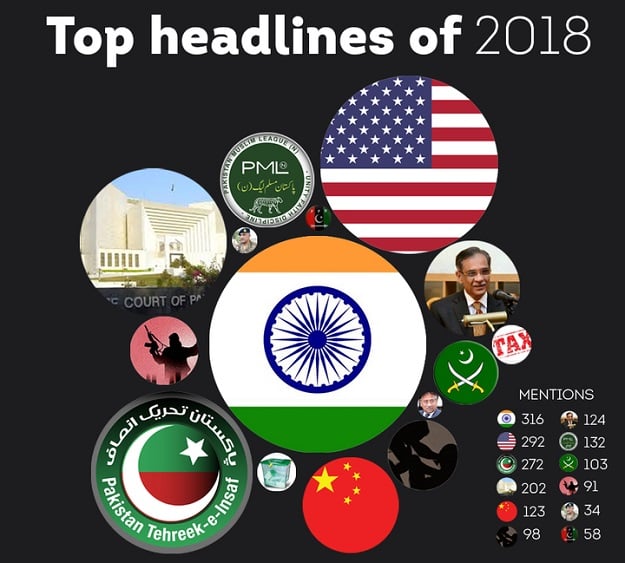 CREATIVE: IBRAHIM YAHYA
CREATIVE: IBRAHIM YAHYAPolitics
Pakistani readers love reading about politics. In fact, the most popular stories everyday center on developments within the country's political sphere. In 2018, both in print and on digital, political parties enjoyed top news coverage.
Pakistan Tehreek-e-Insaf (PTI) came out on top in the struggle for public attention and dominated headlines in both print and digital. Pakistan Muslim League - Nawaz (PML-N) was second, and Pakistan Peoples Party (PPP) a distant third. This might have been a natural consequence of the aggressive tactics of PTI and PML-N leaders in terms of guiding mass discourse, whereas the PPP contended itself to sporadic political statements, mostly on policy issues.
PTI was also significantly more popular on digital platforms as compared to print, as evidenced by a massive difference in PTI-related top stories on both mediums. Interestingly, political parties primarily belonging to K-P and Balochistan got very little attention from readers.
2018 was an election year in Pakistan and news consumption related to polls was very high. Election Commission of Pakistan was popular in print, but digital readers were barely interested in their stories. This imbalance might have had something to do with the fact that ECP stories mostly covered rules and regulations related to the conduct of elections, and therefore got more coverage in print editions.
The controversy surrounding the failure of Results Transmission System was covered in both print and digital but was significantly more popular with digital readers. However, a surprising anomaly in the data was related to rigging claims. According to numbers of the digital edition, not a single story related to rigging made it to daily top stories during the year.
Security
2018 has seen a significant decrease in terror attacks in Pakistan, compared to the previous few years. Top government officials have repeatedly made statements about solidifying gains made against terrorists, as the state moves to dismantle sleeper cells and freeze financial support to these groups after hard-fought military gains.
Tehreek-e-Taliban Pakistan and Baloch Liberation Army, two of the most notorious terror groups involved in attacks inside Pakistan only made a few appearances in the headlines, which underlines their declining influence in the country. Bomb attacks have also decreased, although terrorists still managed to strike a few urban centres during the course of the year.
The armed forces of the country regularly make headlines. Although most military-related stories come through Inter-Services Public Relations, the army chief also issues public statements at state functions.
However, in print and digital, stories directly attributed to ISPR formed only a small part of the mentions related to the army. The army chief gets more space in print, while updates regarding the military were significantly more popular with the digital readership.
Orient meets Occident as Louvre Abu Dhabi rains light on art
Judiciary
Supreme Court of Pakistan was the most widely covered keyword from headlines this year. The court presented landmark judgments in a myriad of cases which garnered the attention of the masses.
Chief Justice Saqib Nisar was also very popular and made it to the front page in print on seventy-four occasions, which mostly quoted remarks he had made while conducting court hearings of sensitive cases.
Interestingly, while the top court was in the news, lower courts and even the high courts, were largely absent from top stories. Although the word court was used 142 times in front page print headlines this year, most stories out of these were related to SC. A similar trend was observed on digital.
Of the high-profile cases that the court took up, a few were more popular than others. For example, in the verdict on Avenfield Apartments reference, the court sentenced former premier Nawaz Sharif to 10 years in prison, his daughter Maryam to 7 and son-in-law, Captain (retd) Muhammad Safdar, to one-year. Despite facing political ramifications for the ruling, the judges appeared unfazed.
The court also held a number of hearings in the treason case against former president General (retd) Pervez Musharraf, and stories about the commando proved very popular with both digital and print readers.
The Panama Papers case against the Sharif family and the fake accounts case, linked to PPP leader Asif Zardari, also made an appearance in top stories of the year.
Social development
The media in Pakistan is often chided for not focusing on social development and giving extraordinary coverage to political issues of little consequence. In 2018, this contention appeared to largely hold ground. Social issues were mostly absent from top stories in both print and digital throughout the year.
Even though the rape and murder of a minor girl in Kasur got widespread news coverage, the outrage surrounding the broader child abuse issues at stake largely died down within a few weeks. Other stories related to violence against women also did not get much coverage, with only a grand total of nine getting top-page coverage in print.
On digital, the numbers tell a slightly different story. More than a 100 stories about violence against women made it to the top stories of the day. The reasons for this huge disparity are not immediately clear.
The Long-Term Climate Risk Index ranked Pakistan as the 8th most affected country from climate change in 2018. But environmental issues, barring a few headliners about building new dams, have not appeared in top stories in print or digital.
Even though the print edition of the newspaper had one solitary headline about climate change, on digital, not even a single story related to the environment appeared in top stories of the day in 2018. Readers and editors need to realise the urgency of the environmental issues at hand and put a lot of effort into changing these statistics.
Other social problems, like new taxes, salaries, education and stories about public issues were also absent from top headlines of the year. Education is a particularly pressing problem in Pakistan, but only made it to the front page on two occasions this year.
In top stories on digital, education gets no mention at all. Perhaps the audience of the newspaper share blame for this, as a few stories about education crisis did appear on digital and print, but got little attention from the public.
The incredible story of the man who raised Malala
Foreign policy
A few key developments in the international arena influenced top headlines about eastern and western neighbours of Pakistan. Rising tensions with India at the beginning of the year contributed a lot of stories to both print and digital, but a thaw in relations toward the end with the opening of the Kartarpur corridor between the two nations got the most attention.
In addition, China was a constant presence on top headlines of The Express Tribune. Most of these stories were about China-Pakistan Economic Corridor (CPEC), although meetings between top officials from both countries also made the front pages. Afghanistan and Iran enjoyed some coverage as well but compared to India and China, these present less than 25% of total news about Pakistan's neighbours.
2018 started with US President Donald Trump firing off a 50-word tirade against Pakistan on social networking website Twitter. The statement set off alarm bells in Islamabad and dominated headlines for more than a month. Stories about the US take up more than half of the total news coverage related to the West in Pakistan, which speaks volumes about the crucial relationship between the two countries.
The United Kingdom, European allies such as France, Italy and Netherlands, as well as African countries like Somalia, Nigeria and Egypt also appeared in top stories of 2018.
With Pakistan on brink of financial collapse, recent loans from brotherly Muslim countries have helped ward off an immediate crisis. The historic ties between Pakistan and Muslim nations like Saudi Arabia, Turkey, United Arab Emirates and Indonesia are always of interest to readers, and 2018 was no different.
Even a cursory glance at these numbers is enough to provide credence to the claim that there is no great divide between print and digital, and the two actually feed off each other.


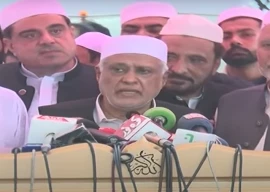
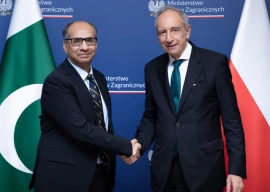

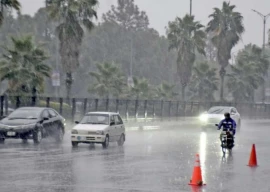












COMMENTS
Comments are moderated and generally will be posted if they are on-topic and not abusive.
For more information, please see our Comments FAQ